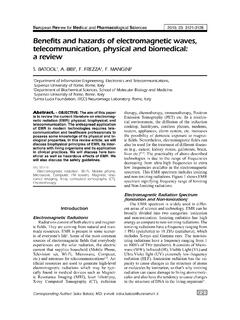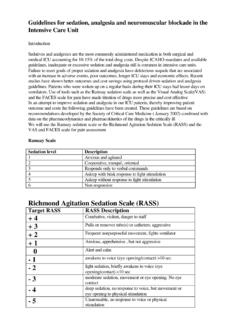Transcription of Eur Rev Med Pharmacol A short introduction to …
1 European Review for Medical and Pharmacological Sciences 2002; 6: 33-44. A short introduction to pharmacokinetics R. URSO, P. BLARDI*, G. GIORGI. Dipartimento di Farmacologia Giorgio Segre , University of Siena (Italy). *. Centre of Clinical Pharmacology, Department of Internal Medicine, University of Siena (Italy). Abstract. Phamacokinetics is proposed introduction to study the absorption, the distribution, the bio- transformations and the elimination of drugs in man and animals. Pharmacokinetics is proposed to study the A single kinetic profile may be well summa- absorption, the distribution, the biotrasfor- rized by Cmax, Tmax, t2 and AUC and, having more mations and the elimination of drugs in man than one profile, 8 parameters at least, the mean and animals1.
2 Absorption and distribution in- and standard deviation of these parameters, may well summarize the drug kinetics in the dicate the passage of the drug molecules from whole population. the administration site to the blood and the A more carefull description of the data can be passage of drug molecules from blood to tis- obtained interpolating and extrapolating the sues respectively. Drug elimination may oc- drug concentrations with some mathematical cur through biotrasformation and by the pas- functions. These functions may be used to re- sage of molecules from the blood to the out- duce all the data in a small set of parameters, or side of the body through urines, bile or other to verify if the hypotheses incorporated in the functions are confirmed by the observations.
3 In routes. Figure 1 shows two graphic represen- the first case, we can say that the task is to get a tations of these processes. simulation of the data, in the second to get a Measuring the amounts or the concentra- model. tions of drugs in blood, urines or other fluids The functions used to interpolate and reduce or tissues at different times after the adminis- the pharmacokinetic data are the multiexponen- tration, much information can be obtained on tial functions and the reference models are the compartmental models whose solutions are just drug absorption and on the passage of drug the multiexponential functions. Using models, molecules between blood and tissues and fi- new meaningfull pharmacokinetic parameters nally on the drug elimination.
4 Figure 2 shows may be defined which can be used to find rela- the results of a hypothetical pharmacokinetic tionships between the drug kinetic profile and experiment. Notice that the scale of the plot the physiological process which drive the drug is not homogenous, because drug in urines absorption, distribution and elimination. For ex- and in the absorption site are amounts, while ample, compartmental models allow to define easily the clearance which is dependent on the the other curves represent drug concentra- drug elimination process, or the volume of distri- tions. bution which depends on the drug distribution in Pharmacokinetics is important because: the tissues.
5 Models provide also an easy way to get an estimate of drug absorption after ex- a. The studies completed in laboratory ani- travasculare drug administration (bioavailability). mals may give useful indications for drug Model building is a complex multistep process where, experiment by experiment and research and development. For example simulation by simulation, new hypothesis are less powerful molecules in vitro can turn proven and disproven through a continuous in- out more effective in vivo because of teraction between the experimenter and the their favorable kinetics (greater absorp- computer. tion, better distribution, etc.). b. Pharmacokinetics supports the studies of Key Words: preclinical toxicology in animals (toxico- pharmacokinetic models, Multiexponential func- kinetics) because the drug levels in plas- tions, AUC, Half-life, Volume of distribution, Clearance, Bioavailability.
6 Ma or tissues are often more predictive than the dose to extrapolate the toxicity 33. R. Urso, P. Blardi, G. Giorgi Drug to be lungs absorbed heart Drug in Drug in Venous tissues tissues blood Arterial blood blood kidneys liver intestine Drug Metabolites excreted Figure 1. Drug absorption and disposition (ie distribution and elimination). A, Graphic representation of the blood circulation: arterial blood is pumped by the heart through all the tissues and after the passage through the organs the venous blood reaches the lungs. All the organs except the lungs are in parallel because they are perfused by a fraction of the whole blood in each passage, while the lungs are in series with the other organs because all the blood reaches the lungs in each passage.
7 Some organs have an arrow to the outside of the body which represents the drug elimina- tion. For example the liver may produce drug metabolites wich in turn enter into the systemic circulation. Notice that the heart is represented just for the mechanical function associated with it, and not as a perfused tissue. B, Blocks which represent the drug absorption, distribution and elimination. Drug to be absorbed Metabolite in blood Drug excreted Drug in blood Hours Figure 2. Observations collected during a hypothetical pharmacokinetic experiment: the unit of measure of y-axis may be not omogeneous because drug to be absorbed and drug excreted are drug amount, while metabolite and drug in blood are concentrations.
8 34. A short introduction to pharmacokinetics data to man. Toxicokinetics is also im- All these informations and the purposes of portant to: the experimenter should always be given verify that the animals have measur- when presenting the design or discussing a able levels of drug in plasma and that pharmacokinetic study. these levels are proportional to the ad- Moreover, as in many protocols the sam- ministered dose, pling times are equal for all the subjects or estimate the area under the curve and animals under investigation, it is good prac- the maximum concentration of the tice at the beginning of the data analysis, to drug in plasma, because these parame- plot not only the observations relative to ters can be used to represent the expo- every single subject, but also the mean (and sure of the body to the drug, standard deviation) concentrations in the evidence differences in pharmacoki- population at each time.
9 Netics between the various groups of Plotting and listing the data may be a big treatment, the days of treatment and job because the size of acquired data during other factors, a pharmacokinetic study is often huge. As estimate the variability between ani- an example, in a typical study of bioequiva- mals and identify cases with abnormal lence in man, there are generally not less levels of the drug. than 12 plasma samples in at least 18 sub- c. Knowledge of the kinetics and of the ef- jects treated with two formulations of the fects (pharmacodynamics) of drugs in same drug. The consequence is that not less man is necessary for a correct use of than 12 18 2 = 432 set of data (time, plas- drugs in therapy (choice of the best ma concentration) are produced.)
10 The num- route of administration, choice of the ber of data increases if also other districts best dose regimen, dose individualiza- have been sampled (urines for example), or tion). if the levels of some metabolite have also been measured. Moreover, as the relationship between the For this reason it is very helpful for evalua- drug levels and the effects is very often inde- tion and communication to sintetize all these pendent on the formulation, formulations data without loosing relevant informations, which produce superimposable drug levels and the following few pharmacokinetic para- can be considered interchangeable and this is meters can be defined: the basis of the concept of bioequivalence.







